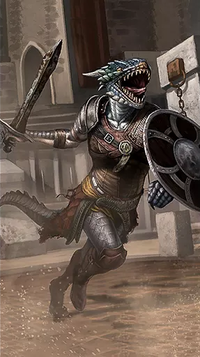Books:Greg Keyes Novels/Development

This page provides an overview of the development of the two Greg Keyes novels.
Origination[edit]
For a long while, series writer/designer Ted Peterson was pitching the production of actual Elder Scrolls novels.[1] Todd Howard was apprehensive, as the production of the books would require on-the-clock attention from senior design staff, which would potentially distract from games' production and cause his development staff to lose focus. The ball got rolling when Pete Hines got conversating about novels with the authors of the game strategies guides, PRIMA Games, and their parent company Penguin Random House. After talking to Penguin, he talked to a few designers about it at Bethesda Game Studios. Hines and series designer Kurt Kuhlmann convinced Todd to go forward with the idea. Together they all made a long list of authors they'd consider commissioning to write the novels, which they combined with a list Penguin offered. One recommendation was writer Greg Keyes, author of The Kingdoms of Thorn and Bone series, which the BGS team really admired. Based on Kingdoms, Bethesda thought he would be a good fit, and sent Keyes a copy of Oblivion along with some written materials to review, Keyes looks these over and agreed it would be a good match. He was subsequently commissioned to produce a duology.[2][3]
Writing & Prewriting[edit]
Keyes was unfamiliar with The Elder Scrolls, as he was not a video gamer. To get accustomed, Keyes played through all of Oblivion and Morrowind and their respective expansions multiple times as different player characters to get a feel for the story, races, and classes of the setting.[4] Bethesda presented him with some internal documentation for source material, though he also fervently utilized The Imperial Library fan website during early outlining and drafting.[4] Keyes specifically worked alongside designers Bruce Nesmith and Kurt Kuhlmann in prose editing and worldbuilding, with additional advising by Todd Howard.[4]
Once he felt comfortable enough with the setting, Keyes began to write. The novels were meant to take place after Oblivion, so BGS presented him a tentative timeline of future events (which contained a number of possible starts), telling him that some things were certainly negotiable, Keyes was then asked to write a series of short proposals for his novels', with narrative options being pretty wide open. BGS selected the ones they liked best, and those couple of proposals were developed into outlines, those made the rounds between Keyes' editor and BGS, until it organized into something everyone was happy with and the novel moved into full production.[4][3] Keyes notes that he was told avoid making the novels' feel "gamey," as the games themselves are merely simplified "representations" of the *actual* setting -- that the fiction itself should feel more real world in scale.[5]
Setting[edit]
Of the setting changes pushed in the novels, Keyes seems to credit himself with a small fraction.[4] Series designers Kurt Kuhlamnn and Michael Kirkbride wanted to vastly change the literal and political landscapes all around Tamriel as a consequence of the Empire falling and the Oblivion Crisis -- this being a nod to the various status quo altering events of the DC Universe.[6] These discussions led to the invention of Red Year with Baar Dau falling and causing the volcanic decimation of Vvardenfell, as well as the invention of the An-Xileel, with the Argonians taking the fight to Dagon, before moving to invade an already ailing Morrowind in the north.[6] Kirkbride put forward the idea of returning the Thalmor/Aldmeri Dominion from PGE1, with the intent of the young and vibrant human culture failing, while the ancient decedent elves actually rouse from those adjectives to make sure the humans fail.[6] The collapse and re-invention of the Empire under the Medes was another plot point.[4] The introduction of Emperor Titus Mede was derived from Kirkbride and Kurt's fanfiction scripts for a mock television show called Star Wars: Rebellion, wherein the character of Titus Mede was a leading man.[7] Keyes acknowledges that he created a "fair amount" of lore for his books, mostly having to do with the Argonians and of course Umbriel, though he reiterates that everything went by the designers at BGS for approval or came out of group conversations about how things should be.[4]
References[edit]
- ^ Camelworks: Ted Peterson Interview
- ^ How Bethesda Made Rogue Warrior More Like Duke Nukem and Got WET with Elder Scrolls Novels
- ^ a b Reading the text: Greg Keyes interview
- ^ a b c d e f g Split Screen: Lord of Scrolls
- ^ Interview With Greg Keyes
- ^ a b c Michael Kirkbride's Posts
- ^ Star Wars: Rebellion